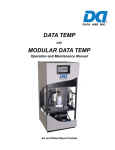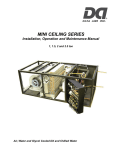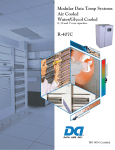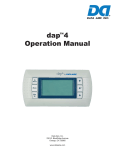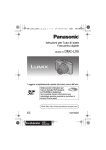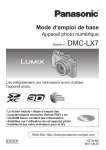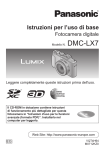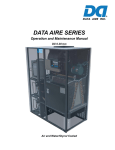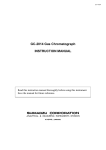Download Data Aire DAMW/G-02 Unit installation
Transcript
Data Cool Installation, Operation and Maintenance Manual 2 and 3 ton Air, Water and Glycol Cooled DX and Chilled Water CONGRATULATIONS ON THE SELECTION OF A DATA AIRE PRECISION ENVIRONMENTAL CONTROL SYSTEM. PROPER INSTALLATION, OPERATION AND MAINTENANCE OF THIS EQUIPMENT WILL ENSURE YEARS OF OPTIMAL PERFORMANCE. This manual is intended to assist trained service personnel by providing necessary guidelines for this particular equipment. Installation and service to Data Aire units should be done by qualified individuals with an adequate background in areas such as HVAC, electrical, plumbing and electronics, as applicable. Service performed by unauthorized or unqualified technicians may void manufacturers’ warranties and could result in property damage and/or personal injury. Special care should be given to those areas where these symbols appear. 2 Table of Contents MODEL IDENTIFICATION ........................................................................ 5 1.0 INSTALLATION .......................................................................................... 6 1.1 1.2 1.3 1.3.1 1.4 1.5 1.6 2.0 PIPING ........................................................................................................ 8 2.1 2.1.1 2.1.2 2.1.3 2.1.4 2.2 2.2.1 2.2.2 2.2.3 2.2.4 2.3 2.4 2.5 2.6 2.7 3.0 3.1 3.2 3.3 3.4 3.5 4.0 4.1 4.2 4.3 4.4 4.4.1 Room Considerations ................................................................................................ 6 Inspection .................................................................................................................. 6 Locating the Unit ........................................................................................................ 6 Indoor Condensing Unit .............................................................................................. 7 Leveling Legs ............................................................................................................ 7 Paperwork ................................................................................................................. 7 Storage ...................................................................................................................... 7 Split Air Cooled Unit Piping ........................................................................................ 8 Liquid Lines ............................................................................................................... 8 Suction Lines ............................................................................................................. 8 Connection Sizes, Air Cooled Units ............................................................................ 9 Field Piping, Remote Condensing Unit....................................................................... 9 Water/Glycol Cooled Unit Piping .............................................................................. 10 Liquid Lines ............................................................................................................. 10 Suction Lines ........................................................................................................... 10 Connection Sizes, Water/Glycol Cooled Units .......................................................... 11 Connection Sizes, Fluid Coolers .............................................................................. 11 Chilled Water Piping ................................................................................................ 11 Condensate Drain Piping ......................................................................................... 11 Humidifier Piping ..................................................................................................... 12 Leak Testing ............................................................................................................ 12 Evacuation ............................................................................................................... 12 ELECTRICAL CONNECTIONS ............................................................... 13 Electrical Service ..................................................................................................... 13 Nameplate Ratings .................................................................................................. 13 Grounding ................................................................................................................ 13 Voltage Tolerance .................................................................................................... 13 Auxiliary Control Wiring ............................................................................................ 13 INSTALLATION OF REMOTE OUTDOOR HEAT EXCHANGER .......... 14 Rigging .................................................................................................................... 14 Locating the Remote Heat Exchanger ...................................................................... 14 Electrical Service ..................................................................................................... 14 Air Cooled Condensers - Model DRCU .................................................................... 15 Fan Speed Control ................................................................................................... 15 3 Table of Contents, continued 5.0 CHARGING ..................................................................................................................... 15 5.1 Voltage Phase Check ............................................................................................................ 15 5.1.1 Evaporator ..................................................................................................................... 15 5.1.2 Secondary Heat Exchanger ............................................................................................ 15 5.2 Air Cooled Systems ....................................................................................................... 15 5.2.1 Split Indoor Air Cooled Systems Charging ...................................................................... 15 5.2.2 Fan Speed Control System Charging ............................................................................. 16 5.3 Water/Glycol Cooled Systems ........................................................................................ 17 5.3.1 Water/Glycol Cooled Systems Charging ......................................................................... 17 5.4 Refrigerant Handling ...................................................................................................... 18 5.5 Important Refrigeration Components .............................................................................. 18 5.5.1 Expansion Valve ............................................................................................................ 18 5.5.2 High Pressure Cutout Switch ......................................................................................... 18 5.5.3 Low Pressure Cutout Switch .......................................................................................... 18 6.0 6.1 6.2 6.3 6.4 6.5 7.0 7.1 7.2 7.3 7.4 7.5 7.6 CONTROLS ................................................................................................................... 18 Standard Thermostat ...................................................................................................... 18 Optional Programmable Thermostat............................................................................... 19 Optional Mini DAP II Microprocessor Control Panel ........................................................ 19 Optional DAP II Microprocessor Control Panel ............................................................... 19 Wiring Diagrams ............................................................................................................ 19 REGULAR MAINTENANCE ITEMS .............................................................. 20 Air Filters ....................................................................................................................... 20 Bearings ........................................................................................................................ 20 Humidifier Canisters ...................................................................................................... 20 Fuses ............................................................................................................................ 20 Heating Elements........................................................................................................... 20 Refrigerant Filter Drier ................................................................................................... 21 8.0 WARRANTY ............................................................................................... 22 9.0 CONTACT DATA AIRE ................................................................................................ 23 Line Sizing Chart ......................................................................................................................... 24 Monthly Maintenance Inspection Checklist .............................................................................. 25 Quarterly Maintenance Inspection Checklist ............................................................................ 26 INDEX .................................................................................................................................. 28 - 29 4 Model Identification 5 1.0 INSTALLATION There is no intent on the part of Data Aire, Inc. to define local codes or statutes which may supercede common trade practices. The manufacturer assumes no responsibility for their interpretation. Consult local building codes and the National Electrical Code for special installation requirements. 1.1 Room Considerations Precision air conditioning equipment is designed to control spaces within close tolerances of temperature and humidity. However, the room must be built with a proper vapor barrier. A film of polyethylene is often used on walls and ceilings. Walls and floors must also be painted with a vapor-seal paint. All doors to the data room should be equipped with weather seals to prevent the infiltration of non-neutral conditioned air from entering the data room. Failure to provide a vapor barrier can compromise the ability to control space conditions. Introduction of outside air into the space should be minimized. Outside air in excess of 5% of the total circulated air volume can have a significant effect on the overall space conditions and result in poor space control. All outside air that is introduced into the space should be conditioned to the humidity and temperature parameters of the computer room air conditioning (CRAC) unit set points to maintain proper room conditions and to prevent the CRAC units from running excessively to maintain the room conditions. 1.2 Inspection This Data Aire unit has been factory run-tested and has gone through a comprehensive inspection prior to its packaging and shipment to ensure that it arrives in excellent condition. However, shipping damage can occur and a visual inspection of the outer crating immediately upon delivery should be performed. Note any external damage or other transportation damage on the freight carrier’s forms. Inspect the unit itself for internal damage. A claim should be filed with the shipping company if the equipment is damaged or incomplete. Loose items such as thermostat or other optional control panels are shipped with the unit. Refer to the manila shipping tag located on the unit panel for details Freight damage claims are the responsibility of the purchaser. Action to recover losses should be filed immediately with the freight company. Refer to yellow shipping tag located on the unit door for details Freight damage claims are the responsibility of the purchaser. Action to recover losses should be filed immediately. Please notify factory personnel of any claims. 1.3 Locating the Unit When installing the unit, sufficient space must be allowed for airflow clearance, wiring, plumbing and service access. It is recommended that each side and front have a clearance of at least 12" to allow servicing of the unit. Some sides may not require as much service clearance. Refer to the unit component drawings for assistance. Rear clearance is not required. 6 Note to Installing Contractor: Condensation formation and frequent humidifier flushing (when humidifier is installed) are normal functions of this equipment. Drain connections must be made to ensure proper water removal. Unit will require drain connections for condensate removal and water connections possibly for humidifier (when installed) makeup water, chilled water and/or hot water. Installation of units above equipment that could sustain water damage should be avoided. 1.3.1 Indoor Condensing Units These 24” tall section is to be mounted using four threaded rods. Air cooled condensing units have factory provided duct collars on the supply and intake air openings as appropriate. Split water cooled condensing sections do not require airflow connections. Typical installations have the condensing section physically near the evaporator, especially since most have shared electrical line power. 1.4 Leveling Legs Each Data Cool comes equipped with four leveling legs. When mounting the unit on the floor, to ensure the best possible operation the leveling legs should be adjusted so that the unit is level. 1.5 Paperwork Each Data Aire unit ships with a start-up sheet that must be completed during installation, and start up of the unit(s). Also included in the paperwork is a warranty/information packet that provides important wiring diagrams, specific component literature, warranty registration card and other valuable paperwork, including a copy of this Installation/Operation and Maintenance manual. A manila tag is attached to the outside panel to indicate articles that may have been packaged and shipped loose within the unit cabinet. This could be the thermostat or other optional control devices that are not factory mounted. It is the responsibility of the installing contractor to return the start-up sheet and warranty registration card to Data Aire for proper activation of the unit warranty. Failure to do so may cause delays in warranty related services and in some cases void the warranty. 1.6 Storage Your Data Aire equipment comes ready for immediate installation. In some instances it may be necessary to store the equipment for a period of time. If you must store the equipment it should be done in a dry area, out of the weather, protected from freezing temperatures, protected from damage by other equipment in storage or transportation equipment, never stacked, and avoid frequent relocation. If equipment is stored for longer than 30 days special precautions must be taken to avoid coil damage. All coils should be charged and sealed with a low pressure (less than 25 psig) inert gas, such as nitrogen. This prevents contaminates from entering the coils; then when the seal is broken at installation, the rush of escaping gas verifies the coil is still leak free. If coils are not charged and sealed condensation mixes with air pollutants forming a weak acid and can cause pin hole leaks to develop in the coil tubes. When equipment is installed after storage caution should be taken to inspect and replace, if required, rubber hoses. All moving parts, such as blowers and motors, should be hand tested to ensure that they are free and clear prior to start-up. Finally, verify that all lubrication is fresh and full. It is the responsibility of the installing contractor to return the start-up sheet and warranty registration card to Data Aire for proper activation of the unit warranty. Failure to do so may cause delays and in some cases void the warranty. 7 2.0 PIPING 2.1 Split Air Cooled Unit Piping Refer to the attached Line Sizing chart on page 24 for a guideline for sizing refrigerant lines. The ultimate responsibility for line size selection is that of the installing contractor or project engineer. Data Aire does not assume this responsibility. The chart covers distances up to 200 equivalent feet. For installations beyond this distance, consult ASHRAE or similar references. Standard piping practice must be used to ensure proper oil return and efficient operation. The interconnecting lines to the remote air cooled condensing unit must be installed by a qualified refrigeration mechanic. The discharge, suction and liquid lines need to be refrigerant grade copper and in accordance with local code. All refrigeration piping should be installed with high temperature brazed joints. When brazing, a supply of nitrogen gas needs to be fed through the refrigerant lines. Be sure to open the other end of the refrigerant line allowing the nitrogen to bleed off and not cause excess pressure buildup. Data Aire recommends a silver/phosphorus/copper alloy with between 5% and 15% silver be used to braze refrigerant line set to the indoor and outdoor units. Nitrogen needs to be flowing through the lines to eliminate carbon deposit buildup on the inside of the joints which could contaminate the refrigerant and restrict the metering device. 2.1.1 Liquid Lines Liquid line size is determined by pressure drop and velocity. The liquid line pressure drop should not exceed 5 PSI. The recommended velocity should be between 200 and 300 FPM. To avoid excessive liquid line pressure drop, the air cooled condensing unit should be located above or at the same level as the evaporator. Condensing unit installation more than ten feet below the evaporator should be avoided. 2.1.2 Suction Lines This unit has the compressor in the condensing unit and requires field piping of liquid and suction lines. Suction lines are trapped similarly to discharge lines. Common practice for suction line selection and installation should be followed. 8 2.1.3 Connection Sizes, Air Cooled Units Model Liquid Suction DACU 02 1/2" 3/4" DACU 03 1/2" 3/4" DACU 04 1/2" 3/4" DACU 05 1/2" 3/4" Note: Unit will have a Liquid Line and Suction Line Field connections at the indoor evaporator and remote condensing unit will not necessarily be the same as the field pipe size required. In some cases these sizes will vary significantly. 2.1.4 Field Piping, Remote Condensing Unit 9 2.2 Water/Glycol Cooled Unit Piping The required field installed condenser water pipe sizes may or may not be the same as the connection sizes at the evaporator or fluid cooler. This will depend on the length of pipe and the calculated pressure drop of peripheral components. Remote water cooled condensing units may also be connected to building water or tower water sources. Pipe size will depend on length of run and the maximum water flow required. Shutoff valves should be installed within a few feet of the inlet and outlet connections of the evaporator to allow the unit to be isolated for service. A fill valve with a hose bib connection should also be used on the supply line or return line at the unit to allow the unit to be drained. Water/glycol cooled units with plate-fin type condensers ship with a strainer. Strainer should be field installed on the inlet water pipe. Strainers must be cleaned periodically. 2.2.1 Liquid Lines Liquid line size is determined by pressure drop and velocity. The liquid line pressure drop should not exceed 5 PSI. The recommended velocity should be between 200 and 300 FPM. To avoid excessive liquid line pressure drop, the air cooled condensing unit should be located above or at the same level as the evaporator. Condensing unit installation more than ten feet below the evaporator should be avoided. 2.2.2 Suction Lines This unit has the compressor in the condensing unit. These cases require field piping of liquid and suction lines. Suction lines are trapped similarly to discharge lines. Common practice for suction line selection and installation should be followed. One of the most common problems in a water/glycol system is the presence of air in the condenser water loop. Air vents must be installed in various locations in the piping system to purge the air, including the highest point in the water loop.. Data Cool 10 2.2.3 Connection Sizes, Water/Glycol Cooled Units Evaporator Model DACW/G 02 DACW/G 03 Water IN and OUT Connections, OD 3/4” 3/4” 2.2.4 Connection Sizes, Fluid Coolers Fluid Cooler Model DAFC 06 DAFC 07 DAFC 09 DAFC 11 DAFC 15 DAFC 17 2.3 Water IN and OUT Connections, OD 1-5/8" 1-5/8" 1-5/8" 2-1/8" 2-1/8" 2-5/8" Chilled Water Piping Units with Chilled Water cooling require a separate source of chilled water. These chilled water connection sizes will be equal to the condenser water connection sizes on the chart in Section 2.2.3. 2.4 Condensate Drain Piping The evaporator section is equipped with a 3/4" FPT connection on the bottom for condensate removal. A union is recommended at the field connection which will permit easy disconnection from the unit for cleaning. A trap should be built into the drain line to prevent air from backing up into the unit. Drain lines should be pitched downward not less than 1/4" for each ten feet of horizontal run. Do not reduce the size of the drain line. Where local codes permit, PVC pipe may be used. Some applications have no convenient means of allowing a gravity drain. In this case, a condensate pump can be used. These come either factory mounted or shipped loose. Factory mounted condensate pumps do not require a separate power source and the alarm switch is wired to the control system. Condensate pumps that are not factory mounted ship loose (or field provided) typically require a dedicated 110 volt power source. Always check the pump power requirements before connecting power. Field pipe connections must be made to the pump discharge connection. A check valve must be installed to prevent short cycling. 11 2.5 Humidifier Piping The optional humidifier offered on Data Cool is a steam generator type with a disposable cylinder. The humidifier makeup water should be brought to the humidifier through the field connection opening using 1/4" copper tubing. A compression fitting is provided at the humidifier. A shutoff valve should be provided outside the air conditioner to allow disconnection for service. An in-line water pressure regulator and strainer should be installed. Water pressure should be set between 30 and 50 PSI. The humidifier has a drain at the bottom which is factory piped to the main condensate drain line. The dispersion tube also has a drain line. No additional field piping is required. 2.6 Leak Testing No installation is complete until the entire system has been thoroughly checked for leaks. This includes checking refrigerant tubing, flare fittings, pressure controls, shrader fittings and compressor rotolock service valves. In addition to the refrigeration system, check all condensate lines, humidifier makeup lines, condensate lines, condensate pumps, chilled water lines, centrifugal pumps and fluid coolers as applicable. When handling and recovering refrigerant, it is not permissible to release refrigerant into the atmosphere. Many leak-test methods recommended in the past are no longer possible. Current standard practices must be used. One acceptable method of leak testing air cooled systems does not involve the use of refrigerant. Prior to charging, pressurize the system to 150 psi with dry nitrogen with all refrigerant valves open. Place a gauge on the line and allow at least four hours before observing if the pressure reading has changed. Tightening of fittings and valves is the responsibility of the installing contractor. 2.7 Evacuation It is of the utmost importance that proper system evacuation and leak detection procedures be employed. Data Aire recommends a minimum evacuation to 500 microns. Good evacuation processes include frequent vacuum pump oil changes and large diameter, short hose connections to both high and low sides of the system preferably using copper tubing or bronze braided hose. If the compressor has service valves, they should remain closed. A deep vacuum gauge capable of registering pressure in microns should be attached to the system for pressure readings. A shut-off valve between the gauge connection and vacuum pump should be provided to allow the system pressure to be checked after evacuation. Do not turn off vacuum pump when connected to an evacuated system before closing shutoff valve. Do not apply power to the compressor when in a vacuum. 12 3.0 ELECTRICAL CONNECTIONS Before proceeding with the electrical connections, make certain that the volts, hertz and phase correspond to that specified on the unit electrical nameplate. Units damaged from incorrect power input will not be covered under warranty. Use copper conductors only. 3.1 Electrical Service Check to be sure the service provided by the utility is sufficient to handle the additional load imposed by this equipment. Indoor unit has a single power source. Indoor split units typically have a single power source but can also be provided with separate sources. Field-provided, interconnecting control wires are also required. Units with outdoor secondary heat exchangers will require a separate power source and field-provided, interconnecting control wires as well. See section 3.5 below. Remote outdoor condensing units require one power source. Glycol systems with fluid coolers and loose pump(s) typically require one power source for the fluid cooler and will require one additional source for a single pump or two additional sources for dual pumps. Systems where the pump(s) are mounted and piped integral to the fluid cooler will usually require a single power source. 3.2 Nameplate Ratings Refer to the unit electrical nameplate for equipment electrical requirements. Minimum Circuit Ampacity, also known as Wire Sizing Amps, will dictate the minimum required wire gauge. Maximum Overcurrent Protection Device amps will dictate the maximum circuit breaker or fuse size. 3.3 Grounding The unit cabinet must have an uninterrupted true earth ground. An electrical ground wire of adequate size must be connected to the ground lug provided inside the main electrical box. 3.4 Voltage Tolerance The supply voltage to the unit must be within tolerance of -5% +10% for 208-230 voltage,+/- 10% for 460 voltage. The local utility company should be contacted for correction of improper line voltage. Deviation from voltage ratings can cause premature failures and possibly void unit warranties Check the wiring connections in the unit control panel to ensure they are tight. Screw terminals may come loose in transit. Tightening of wiring connections is the responsibility of the installing contractor. 3.5 Auxiliary Control Wiring The outdoor condensing unit requires its own power source and ground source. A disconnect (field provided) is required to be installed to isolate the unit for maintenance and service. Check nameplate voltage ratings to ensure field power (building power). A field supplied 3 or 4 wire control connection (24 VAC) is required between the evaporator and the condensing unit. All control wiring must be installed in accordance with the National Electrical Code (NEC) Class 1 circuit. See the unit schematic for control wiring details Check the wiring connections in the unit control panel to ensure they are tight. Screw terminals may become loose in transit. Tightening of wiring connections is the responsibility of the installing contractor. 13 4.0 INSTALLATION OF REMOTE OUTDOOR HEAT EXCHANGER 4.1 Rigging This section covers outdoor condensing units and fluid coolers. Outdoor heat exchangers should be moved to their (typically rooftop) mounting location using a crane or fork lift. Each fan section has supports with lifting holes at the top. Do not lift with a choke sling around the unit. Spreader bars are recommended for lifting multiple fan units. Under no circumstances should the coil headers or piping be used for lifting the unit. Ideally, the unit should be kept in its shipping crate until it is ready to be set in place. Concrete pads or rails are often used to provide support for the heat exchanger. Bolt holes in the bottom of each leg can be used to anchor the unit. 4.2 Locating the Remote Heat Exchanger Consult local codes or ordinances for restrictions regarding location of unit. Select a location for the unit where ice and snow will not fall from an overhang and damage the unit top or fan blade. Care must be exercised to maintain the clearance requirements. Air cooled condensing units should be placed at a level that is above the level of the indoor evaporator. Mounting a condensing unit more than ten feet below the evaporator is not recommended. Excessive liquid line pressure drop can cause poor evaporator performance. See dimensional drawings for the following: 1. 2. 3. 4. Location of refrigeration and electrical connections Recommended clearances Direction of condenser airflow Mounting base dimensions Place unit on level base strong enough to support the weight of the unit and resist effects of frost heaving, etc. Concrete lintels can be used if spaced to adequately support unit. Allow air to circulate under unit. Channels are provided for this purpose or unit may be set in a bituminous mixture such as roofing tar to prevent base pan from rusting. Do not plug drain holes. On rooftop applications, locate unit at least 6 inches above roof surface. Where possible, place unit above load-bearing wall. Arrange supporting members to adequately support unit and minimize transmission of vibration to building. Precast concrete lintels, concrete blocks, treated timbers or steel beams can be used. Consult local code governing rooftop applications. In cold climates locate unit above expected snow levels. Avoid locations where flowers, shrubs, etc. are in the pathway of condensing unit air discharge or where the condensing fan will discharge against prevailing wind or a building structure. 14 4.3 Electrical Service Refer to Sections 3.1 to 3.5 for information regarding line voltage and control voltage wiring details. 4.4 Air Cooled Condensing Unit - Model DRCU 4.4.1 Fan Speed Control Standard outdoor air cooled condensing units have a fan speed controller on the first fan. On single-fan condensing unit this is the only means of control. A variable speed controller modulates the motor speed based on system head pressure. The fan speed controller will normally not require field adjustment. 5.0 CHARGING 5.1 Voltage Phase Check 5.1.1 Evaporator Prior to charging, the correct voltage phasing should be checked on the indoor evaporator. Check blower direction on the evaporator by momentarily energizing the fan motor. Reverse any two of the three line voltage wires at the line voltage field connection point to change the blower rotation. Although the scroll compressor is phase dependent, units shipped from the factory are run tested, ensuring the compressor rotation is consistent with the evaporator fan motor. However, a field changeout the compressor may require checking proper phase. An out-of-phase compressor will draw relatively low amps and both suction and discharge pressures will remain nearly equal. 5.1.2 Secondary Heat Exchanger The secondary heat exchanger may be ordered as three phase but the individual fan motors are single phase and will only run in one direction. 5.2 Air Cooled Systems Before starting a compressor, the crankcase heater should be energized for a minimum of 12 hours to reduce the possibility of liquid slugging on start-up. Failure to energize the crankcase heater could result in compressor damage. 5.2.1 Split Indoor Air Cooled Systems Charging After the field refrigerant piping is properly completed, connect the refrigerant drum to the low side and charge with vapor. Charge with approximately three lbs. per nominal ton. For example, a model DACU 0334-AO is a nominal 3 ton unit. Charge with about 9 lbs. of refrigerant to begin. It is likely that more refrigerant will be required to complete the charging procedure. Make sure all hoses are properly purged. Before starting a compressor, the crankcase heater should be energized for a minimum of 12 hours to reduce the possibility of liquid slugging on start-up. Failure to energize the crankcase heater could result in compressor damage. 15 Start the evaporator fan and compressor. Check the liquid line sight glass to get a feel for the approximate charge. Bubbles in the sight glass are not unusual at this point and can be caused by flashing from liquid line pressure drop, low sub-cooling or low charge. It is likely that more refrigerant will be required to complete the charging procedure. Adjust the refrigerant charge until the sight glass clears or has only sparse bubbles. The unit should be allowed to stabilize for several minutes before meaningful measurements can be taken. A properly charged system operating at typical parameters will have a head pressure of 225 to 275 psi. Suction pressure should be 58 psi or greater. The superheat at the compressor suction line at least 6 inches away from the compressor should be 8-15°. Note: Charging to a full liquid line sight glass should never be the sole means of determining the correct refrigerant charge. Other parameters such as superheat, suction pressure, head pressure, sub-cooling and ambient temperature are also important parameters. A system charged to a clear sight glass is often overcharged. 5.2.2. Fan Speed Control System Charging The standard outdoor air cooled condensing for Data Aire equipment is a fan speed control system. After the field refrigerant piping is properly completed, connect the refrigerant drum to the low side and charge with vapor. Charge with approximately three lbs. per nominal ton plus the line set. For example, a model DCAU 0334-AO is a nominal 3 ton unit. Charge with about 9 lbs. of refrigerant to begin. It is likely that more refrigerant will be required to complete the charging procedure. Make sure all hoses are properly purged. Before starting a compressor, if the system has a refrigerant holding charge, the crankcase heater should be energized for a minimum of 12 hours to reduce the possibility of liquid slugging on start-up. Failure to energize the crankcase heater could result in compressor damage. If the system is charged and started from a vacuum, the preheating of the compressor is not necessary. Start the evaporator fan and compressor. Check the liquid line sight glass to get a feel for the approximate charge. Bubbles in the sight glass are not unusual at this point and can be caused by flashing from liquid line pressure drop, low sub-cooling or low charge. It is likely that more refrigerant will be required to complete the charging procedure. Adjust the refrigerant charge until the subcooling is between 8° F and 10° F and the superheat is between 8° F and 15° F. There may be flashing and/or bubbles in the sight glass when the system is properly charged. The unit should be allowed to stabilize for several minutes before meaningful measurements can be taken. After the system is allowed to stabilize, verification of a few key measurements should be noted. The discharge pressure should be between 225 to 275 psi and the sub-cooling should be 8-10 degrees, depending on ambient conditions. Suction pressure should be 58 psi or greater. The superheat at the compressor suction line at least 6 inches away from the compressor should be 8-15 degrees. Note: Charging to a full liquid line sight glass should never be the sole means of determining the correct refrigerant charge. Other parameters such as superheat, suction pressure, head pressure, sub-cooling and ambient temperature are also important parameters. A system charged to a clear sight glass is often overcharged. 16 5.3 Water/Glycol Cooled Split Systems 5.3.1. Water/Glycol Cooled Split Systems Charging All water/glycol Data Cool units are split systems requiring field charge. After the refrigerant piping and water line piping is properly completed, connect the refrigerant drum to the low side and charge with vapor. Charge with approximately three lbs. per nominal ton. For example, a model DACU 0334-AO is a nominal 3 ton unit. Charge with about 9 lbs. of refrigerant to begin. It is likely that more refrigerant will be required to complete the charging procedure. Make sure all hoses are properly purged. Before starting a compressor, the crankcase heater should be energized for a minimum of 12 hours to reduce the possibility of liquid slugging on start-up. Failure to energize the crankcase heater could result in compressor damage. Start the evaporator fan and compressor. Check the liquid line sight glass to get a feel for the approximate charge. Bubbles in the sight glass are not unusual at this point and can be caused by flashing from liquid line pressure drop, low sub-cooling or low charge. It is likely that more refrigerant will be required to complete the charging procedure. Adjust the refrigerant charge until the sight glass clears or has only sparse bubbles. The unit should be allowed to stabilize for several minutes before meaningful measurements can be taken. A properly charged system operating at typical parameters will have a head pressure of 225 to 275 psi. Suction pressure should be 58 psi or greater. The superheat at the compressor suction line at least 6 inches away from the compressor should be 8-15°. Note: Charging to a full liquid line sight glass should never be the sole means of determining the correct refrigerant charge. Other parameters such as superheat, suction pressure, head pressure, sub-cooling and ambient temperature are also important parameters. A system charged to a clear sight glass is often overcharged. The water regulating valve should be adjusted to maintain 230 to 260 psi head pressure. Suction pressure should be 58 psi or greater. The superheat at the compressor suction line at least 6 inches away from the compressor should be 8-15°. It is necessary to measure and note proper unit operation including superheat, head and suction pressure. Some adjustment to charge may be required. Adjust the refrigerant charge again until the sight glass clears or has only sparse bubbles. The unit should be allowed to stabilize for several minutes before meaningful measurements can be taken. All water/glycol cooled units have a water regulating valve. A head pressure sensing transducer is connected to a shrader fitting on the discharge line and water is regulated into the condenser coil. Condenser coils may be plate fin or coaxial type. 17 5.4 Refrigerant Handling The use of recovery/recycling units is required by U.S. Environmental Protection Agency (EPA) regulations. Technicians who service and dispose of air conditioning and refrigeration equipment must recover the refrigerant instead of venting to atmosphere. Except for extremely small releases of refrigerant such as what occurs when disconnecting service hoses (diminutive release), a technician who knowingly releases or vents refrigerant to the atmosphere is in violation of these regulations. Freon purchasers must be certified technicians and have a valid EPA certification card. 5.5 Important Refrigeration Components 5.5.1 Expansion Valve Each refrigerant circuit has an adjustable thermo-expansion valve (TXV). These are factory adjusted to their nominal rating. Any field adjustment should be to fine tune a system that has stabilized and already has acceptable operating parameters. 5.5.2 High Pressure Cutout Switch Each refrigerant circuit is protected by a high head pressure cutout switch with a manual reset button. The cutout pressure rating for refrigerant R-22 is 400 psi. Physical location is near the compressor which may be either in the evaporator or the condensing section. 5.5.3 Low Pressure Cutout Switch Each circuit also contains a low suction pressure cutout switch with automatic reset. The cutout pressure rating for this switch is 30 psi. Physical location is near the compressor which can be either in the evaporator or the condensing section. 6.0 CONTROLS 6.1 Thermostat Each Data Cool unit is shipped with a cooling only digital thermostat designed to provide accurate control, displays room temperature and cooling on mode. The six buttons on the front of the thermostat allow complete control of the equipment. Setpoints - Raising and lowering the setpoints is accomplished by simply pushing the “Up” or “Down” buttons. The unit will display either Fahrenheit or Celsius. Cooling - Select the temperature by pressing the “Up” or “Down” button. The word “COOL” and the temperature setting is Displayed for five seconds. Fahrenheit/Celsius - Simultaneously press the “Up” and “Down” buttons to switch between Fahrenheit and Celsius temperature setpoint. Follow the provided wiring diagram. 18 6.2 Programmable Digital Thermostat A cooling only digital thermostat designed to provide accurate control, displays room temperature and cooling on mode. The buttons on the front of the thermostat allow complete control of the equipment. Cooling - Select the temperature by pressing the “Up” or “Down” button. The word “COOL” and the temperature setting is displayed for five seconds. Fahrenheit/Celsius - Simultaneously press the “Up” and “Down” buttons to switch between Fahrenheit and Celsius temperature set point. In addition, the thermostat can be programmed for two or four events per day. The events will allow program of a day and night setting. Four events will allow programming of a morning, day, evening and night settings. See the enclosed booklet (Uni-Line 110-809C) for programming details. Follow the provided wiring diagram. 6.3 Optional Mini DAP II Microprocessor Control Panel The Mini DAP II microprocessor control panel is an optional control panel available as an upgrade to the thermostat. There is a separate manual that goes into extensive detail regarding functions, features, programming and troubleshooting. The Mini DAP II microprocessor control panel has an entire manual dedicated to its use and operation. This manual must be referenced to complete a thorough unit installation. Start-up is not complete until the Mini DAP II control panel settings are established. 6.4 Optional DAP II Microprocessor Control Panel The DAP II microprocessor control panel is available as an upgrade to the Mini DAP II panel and offers additional features including remote communications (with additional communication card options). There is a separate manual that goes into extensive detail regarding functions, features, programming and troubleshooting. The DAP II microprocessor control panel has an entire manual dedicated to its use and operation. This manual must be referenced to complete a thorough unit installation. Startup is not complete until the DAP II control panel settings are established. 6.5 Wiring Diagrams Every Data Aire evaporator and condensing unit or fluid cooler comes with a wiring diagram. These diagrams are ‘ladder’- type schematics intended for service personnel. The intent is to allow the technician to understand the wiring details associated with the electrical components and how they interface with the controls as well as peripheral equipment, including secondary heat exchangers. 19 The wiring diagram in the evaporator will indicate field interface terminals to the secondary heat exchanger. The internal wiring of the heat exchanger is found on a separate diagram which can be found on the inside cover of the heat exchanger electrical box. Both diagram types are also placed inside the shipping/ warranty packet that is placed inside the evaporator. Evaporator wiring diagrams will have a drawing number which starts out with the three letter designation, “DCX”. The wiring diagram for the Data Cool is DCX-S-776. Wiring diagrams for the condensing unit start out with the three letter designation, “DRC”. An example of a typical diagram is DRC-S-001. Wiring diagrams for fluid coolers start out with the three letter designation, “DFC”. An example of a typical diagram is DFC-S-001. 7.0 REGULAR MAINTENANCE ITEMS 7.1 Air Filters Air filters should be checked on a regular basis and changed when they become dirty. This will ensure efficient operation of the unit. Spare air filters should be kept in stock as these tend to be a frequently replaced maintenance item. Air filters may require changing as often as monthly. Note also that construction dust on new installations will quickly clog new filters. Air filters that require changing can restrict airflow and create problems such as coil icing or poor air distribution. 7.2 Bearings Blower bearings used on Data Cool units are permanently lubricated and do not require maintenance. 7.3 Humidifier Canisters The optional steam generator type humidifier does not require maintenance other than to replace the canister as required. This frequency will depend on usage and water type. A set of manufacturer’s instructions for the humidifier is sent as part of the paperwork placed inside the unit when it ships. 7.4 Fuses Fuses may occasionally require changing especially with installations where the voltage is not consistent. Drops in voltage can create brief periods of high amp draw, causing fuses to blow. Always replace fuses with those of the equivalent rating with regard to: 1) amperage, 2) voltage, and 3) speed. For instance compressors and motors are inductive loads which require time delay fuses. Electric reheat and humidifiers are resistive loads requiring fast acting fuses. 7.5 Heating Elements The optional heating elements do not normally require maintenance. However sometimes they may accumulate a film of dust or dirt when unused for extended periods of time. When energized, the burning debris can create smoke or unpleasant odor. To help avoid this, periodic cleaning is recommended. 20 7.6 Refrigerant Filter Drier Factory installed refrigerant filter driers do not normally require maintenance. When replacing compressors or other repairs that open the refrigeration system to atmosphere, it is advisable to replace the filter drier. The equivalent type and size should be used. 21 8.0 Warranty Policy Data Aire Inc. warrants your Data Aire environmental control unit to be free from defects in material and workmanship under normal use and service for a period of (18) eighteen months from date of shipment. Our obligation under this warranty shall be limited to repairing or replacing any part or parts, (F.O.B. Orange, California), of your Data Aire unit, which, in our judgment, shows evidence of defect within the period of time heretofore set forth. Upon our request, the said part(s) shall be returned to Data Aire Inc. at Orange, California, transportation charges prepaid. LABOR is not covered by this warranty. ADDITIONAL MOTOR-COMPRESSOR LIMITED WARRANTY: Data Aire Inc. offers for sale additional motor-compressor limited warranties, which warrants the motor-compressor to be free from defective material or workmanship under normal use and service for an additional period as indicated above immediately following the expiration of the STANDARD LIMITED WARRANTY and will repair or replace (F.O.B. Orange, California) the motor-compressor found by it to have become inoperative due to defects in material or workmanship, provided that inspection by Data Aire Inc. established the validity of the claim. The ADDITIONAL MOTOR-COMPRESSOR LIMITED WARRANTY does not include such parts as the cabinet, electrical components and controls, refrigerant, refrigerant tubing, expansion valve(s), pressure relief device, fan motor, filters, water regulating valve(s), if used, or any parts other than the motorcompressor. Failure(s) due to the condition of the water supply or failure due to the entry of water to the motor-compressor as a result of a freeze-up are also excluded. These warranties cannot be transferred or assigned by you and shall run only in favor of the original owner-user of the Data Aire Inc. unit. Prior written authorization by Data Aire, Inc. is required for the return of any parts, which are deemed to be defective. These warranties shall not apply to the replacement of air filters, belts, refrigerant, customer provided parts, heaters not regularly cleaned, correction or conditions due to inadequate or improper air or water supply, improper or incorrectly connected duct work, inadequate wiring, power supply, blown fuses, humidifier cylinders, light bulbs and infra-red lamps, or if, in our judgment, your Data Aire Inc. unit has been subjected to misuse, negligence, accidental damage caused in transit, damage caused by lack of protection from extreme environmental conditions, tampering, alteration in any way, or if the serial number has been abused, altered, defaced, or removed. Additionally, these warranties shall not apply, if in the judgment of Data Aire Inc., the unit has not been serviced and maintained regularly in accordance with established maintenance procedures. Parts that are project specific and deemed special (non-Data Aire catalog items) which are installed and provided by Data Aire Inc. shall be subject to Data Aire’s vendor’s standard warranty. Data Aire will not stock or maintain inventory on such parts. Replacement of project specific parts will be subject to vendor’s standard lead times. Data Aire Inc. shall not be liable for any default or delay in performance under these warranties when caused by any contingencies beyond our control, including war, government restrictions or restraints, strikes, fires, floods, acts of nature or inadequate raw material supplies. Except as stated above, Data Aire Inc. makes no warranty or guarantee, expressed or implied. 22 10.0 Contact Data Aire Address: DATA AIRE INC. 230 W. BLUERIDGE AVE. ORANGE, CA 92865 Phone: 714-921-6000 800-347-AIRE (2473) Toll Free Fax: 714-921-6010 714-921-6011 714-921-6022 Main Engineering Part Sales E-mail: [email protected] Technical Support [email protected] Engineering [email protected] Sales Web site: www.dataaire.com Job Information: Data Aire Job Number: _________________________________________ Evaporator Serial Number: ______________________________________ Evaporator Model Number: _____________________________________ Condensing Unit/ Fluid Cooler Serial Number: __________________________________ 23 RECOMMENDED LINE SIZING FOR AIR COOLED SPLIT SYSTEMS UP TO 200 EQUIVALENT FEET LIQUID LINES SINGLE CIRCUIT SYSTEMS Unit Tons per Tonnage Circuit 2 3 2 3 EQUIVALENT FEET 50 100 150 200 3/8 1/2 1/2 1/2 1/2 1/2 1/2 1/2 SUCTION LINES SINGLE CIRCUIT SYSTEMS EQUIVALENT FEET Unit Tons per 50 100 150 Tonnage Circuit HOR VER HOR VER HOR VER 2 3 HOR = HORIZONTAL 2 3 7/8 7/8 7/8 7/8 7/8 1-1/8 VERT = VERTICAL 24 7/8 7/8 7/8 1-1/8 7/8 7/8 200 HOR VER 1-1/8 1-1/8 7/8 7/8 Data Aire, Inc. Monthly Maintenance Inspection Checklist Model No.__________________ Prepared by: _______________ Serial No. ____________________ Date: ___ / ___/ 201__ Air Filters ___ Check for restricted air flow Electrical Panel ___ Check contactor operation Blower Section ___ Blower wheel free of debris moves freely ___ Check motor mounts Notes: _______________________________ ____________________________________ ____________________________________ ____________________________________ ____________________________________ ____________________________________ ____________________________________ ____________________________________ ____________________________________ ____________________________________ Air Distribution Section ___ Check for restriction in grille(s) Air Cooled Condensing Unit (if applicable) ___ Condensing coil clean ___ Motor Mounts tight ___ Motor fan bearings in good condition ___ Refrigeration lines properly supported Compressor ___ Check for leaks Refrigeration Cycle/Section ___ Check crank case temperature Water/Glycol Fluid Cooler (if applicable) ___ Water regulating valve function ___ Check for water/glycol leaks (piping area) Glycol Pump(s) (if applicable) ___ Glycol leaks (pump area) ___ Pump operation ___ Auto air vent clean of mineral deposits Condensate Drain and Pump (if applicable) ___ Check for water leaks ___ Check for restricted air flow ___ Pump operation Steam Generating Humidifier (if applicable) ___ Check canister for deposits and water level ___ Check condition of steam hose and clamps 25 Data Aire, Inc. Quarterly Maintenance Inspection Checklist Model No. _______________________ Prepared by: _____________________ Serial No. ___________________________ Date: ___ / ___/ 201__ Air Filters ____ Check for restricted air flow ____ Wipe filter rack section clean Reheat (if applicable) ____ Check reheat element(s) for dust ____ Check high limit switch operation Blower Section ____ Blower wheel free of debris and moves freely ____ Check air flow safety switch operation ____ Check motor mounts Electrical Panel ____ Check fuses ____ Check contactor operation ____ Check all electrical connections ____ Check operation sequence Air Distribution Section ____ Check for restriction in grille(s) Air Cooled Condensing Unit (if applicable) ____ Condenser coil clean ____ Motor mounts tight ____ Motor fan bearings in good condition ____ Refrigeration lines properly supported ____ Heated receiver site Refrigeration Cycle/Section ____ Check for moisture (site glass) ____ Check suction pressure ____ Check discharge pressure ____ Check hot gas bypass valve operation ____ Check thermostatic expansion valve operation ____ Check solenoid valve operation Mini DAP control panel operations (Optional) ___ Check calibration of temperature sensor (31*) ___ Check calibration of humidity sensor (35*) * Mini DAP menu options Equipment Runtimes Blower Condenser Compressor Reheat Humidifier Dehumidification Energy Saver ____________ ____________ ____________ ____________ ____________ ____________ ____________ hrs hrs hrs hrs hrs hrs hrs ___ Reset all to read zero runtimes Temperature/Humidity set at: _____° _____% RH Compressor ____ Check for leaks Water/Glycol Fluid Cooler (if applicable) ____ Water regulating valve function ____ Check solution _____% ____ Check for water/glycol leaks (piping area) ____ Water/Glycol flow switch operational Notes: ______________________________________ ___________________________________________ ___________________________________________ ___________________________________________ ___________________________________________ Glycol Pump(s) (if applicable) ____ Glycol leaks (pump area) ____ Pump operation ____ Auto air vent clean of mineral deposits Condensate Drain and Pump (if applicable) ____ Check for water leaks and restricted flow ____ Pump operation Steam Generating Humidifier (if applicable) ____ Check canister for deposits and water level ____ Check condition of steam hose and clamps ____ Check drain and fill valve for deposits 26 27 - F Fan Speed Control Systems .................... 15 Field Piping Air Cooled ........................................... 9 Chilled Water ...................................... 11 Condensate ........................................ 11 Condensing Unit .................................11 Fluid Cooler ....................................... 10 Glycol Cooled .................................... 10 Steam Generator Humidifier .............. 12 Water Cooled .................................... 10 Field Wiring Remote Condensing Unit ................... 13 Remote Fluid Cooler .......................... 13 Filter, Air ..................................................... 20 Drier .................................................. 21 Flow Switch ............................................. 10 Fluid Coolers ........ 10, 11, 12, 13, 14, 19, 20 Fuses ...................................................... 20 -AAir Cooled Systems ... 7, 8, 9, 12, 14, 24, 25 Air Filters ...........................................15, 20 Air Vents ................................................. 10 Ambient Thermostats ................. 6, 7, 18, 19 Auxiliary Control Wiring ........................... 15 - B Bearings ................................................. 20 - C Charging Air Cooled Fan Speed Systems....12, 16 Air Cooled Split Systems ................... 15 Water/Glycol Systems ........................ 17 Coils Condenser ................................ 7, 17, 18 Compressors 8, 10, 12, 15, 16, 17, 18, 20, 21 Crankcase Heaters .......................15, 17 Fan Motor .......................................... 15 Condensate Pumps ................................. 11 Condensing Units ... 7, 8, 9, 13, 14, 15,19,20 Connection Sizes Air Cooled Units .................................. 9 Fluid Coolers ......................................11 Water/Glycol Cooled Units ............ 10, 11 Contact Data Aire ................................... 23 Controls DAP II Control Panel .......................... 19 Mini DAP II Control Panel ................... 19 Programmable Thermostat ................ 19 Thermostat ........................................ 18 Wiring Diagrams ............................... 19 - G Glycol Systems ....................................... 17 Grounding ............................................... 13 - H Head Pressure ...................... 15, 16, 17, 18 Cutout Switch ..................................... 18 Water Regulating Valve .................10, 17 Heat Crankcase .............................. 15, 16, 17 Electric .............................................. 20 Reheat Elements ............................... 20 High Pressure Cutout Switch ................... 18 Humidifier Canister ........................................12, 20 Steam Generator Humidifier ...............12, 20 - D DAP II Control Panel ..........................19, 25 - E Electrical Evaporator ......................................... 20 Outdoor Heat Exchanger......... 13, 15, 17 - I Inspection .................................................. 6 Installation ................................................. 6 Internal Volume see Volume 28 - L Liquid Lines ..................................... 8, 9, 24 Leak Testing ........................................... 12 Locating Evaporator ........................................... 6 Secondary Heat Exchanger ............... 14 Low Pressure Cutout Switch.................... 18 - M Maintenance Bearings ............................................ 20 Filters ................................................ 20 Fuses ................................................ 21 Heating Elements .............................. 21 Humidifier Canisters .......................... 21 Refrigerant Filter Drier ....................... 21 Model Identification ................................... 5 - S Sight Glass ........................................16, 17 Start Up Sheet ........................................... 7 Storage ..................................................... 7 Strainer ..............................................10, 12 Subcooling .............................................. 16 Suction Lines ................. 8, 9, 10, 16, 17, 24 Superheat .......................................... 16, 17 - T Thermo-expansion Valve (TXV) ............... 18 Thermostats Ambient ...................................... 6, 7, 18 Programmable................................... 19 Traps ........................................................ 9 - V Valves Humidifier Makeup Water .................. 12 Shutoff ............................................... 10 Water Regulating ............................... 17 - P Paperwork ................................................ 7 Piping See Field Piping Pumps Centrifugal ......................................... 10 Condensate .................................. 11, 12 Voltage Phase Check ..................................... 13 - W Warranty ......................................... 7, 13, 22 Wiring ...................................... 6, 13, 15, 19 - R Recovery ................................................. 18 Refrigerant ................... 8, 12, 15, 16, 17, 18 Charge see Charging Handling ............................................ 18 Recovery ........................................... 18 Reheat Elements ........................................... 20 Electric .............................................. 20 Remote Condensing Units .. 7 - 11, 13, 14, 15, 20 Fluid Coolers ... 10, 11, 12, 13, 14, 19, 20 Rigging ................................................... 14 29 Notes: _______________________________________________________________________________________ ____________________________________________________________________________________________ ____________________________________________________________________________________________ ____________________________________________________________________________________________ ____________________________________________________________________________________________ ____________________________________________________________________________________________ ____________________________________________________________________________________________ ____________________________________________________________________________________________ ____________________________________________________________________________________________ ____________________________________________________________________________________________ ____________________________________________________________________________________________ ____________________________________________________________________________________________ ____________________________________________________________________________________________ ____________________________________________________________________________________________ ____________________________________________________________________________________________ ____________________________________________________________________________________________ ____________________________________________________________________________________________ ____________________________________________________________________________________________ ____________________________________________________________________________________________ ____________________________________________________________________________________________ ____________________________________________________________________________________________ ____________________________________________________________________________________________ ____________________________________________________________________________________________ ____________________________________________________________________________________________ ____________________________________________________________________________________________ ____________________________________________________________________________________________ ____________________________________________________________________________________________ ____________________________________________________________________________________________ ____________________________________________________________________________________________ ____________________________________________________________________________________________ 230 W. BlueRidge Avenue Orange, CA 92865 800-347-2473 www.dataaire.com e-mail: [email protected] A Member of the CS Group of Companies © 2011 Data Aire, Inc. Data Aire, Inc. reserves the right to make design changes for the purpose of product improvement or to withdraw any design without notice. DACU-IOM-0807 Rev A
































